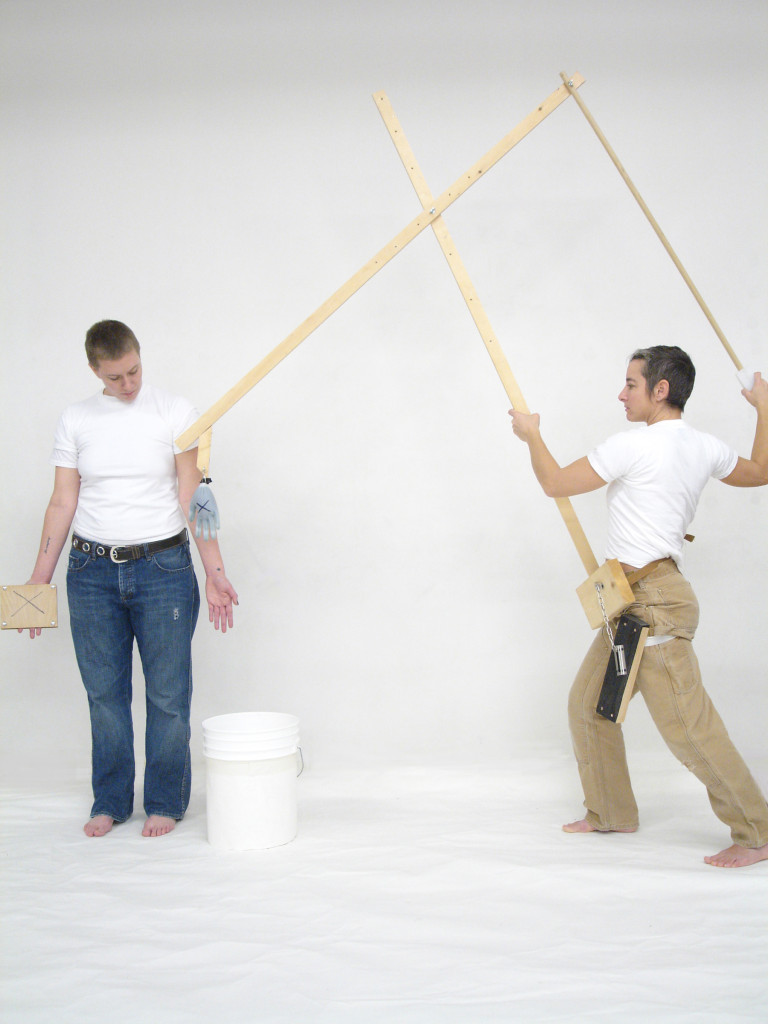Leaping Between Objects and Movement
DiverseWorks Presents Karen Sherman’s One with Others

Karen Sherman One with Others. Pictured LtoR Joanna Furnans and Karen Sherman, Photo by Jeffrey Wells.
“I became a dancer by accident. Or, at least entirely, unintentionally,” says choreographer and dance artist Karen Sherman. “I just kept saying yes. For over 20 years.”
Houston audiences have the chance to follow Sherman on a journey that uses all the major art forms — music, sound, text, light, visual art, movement — when DiverseWorks presents One with Others May 2 and 3 at The Barn, fresh on the heels of her performance of the piece during the FuseBox Festival in Austin.
She describes OwO as a group dance/performance project that “considers biography, choice, and communication, using choreography, handyman arts, and text to explore legacy, what we hand down to one another or lure each other into.” Sherman understands that sometimes hands feel like they are made of wood, a partner is also a nemesis, and words hold us accountable.
In the evening-length performance of OwO, three dancers experiment with, influence, and ultimately determine the functions of their new or augmented appendages, which are made from rough and battered cuts of wood somewhat crudely secured to their bodies with belts, hinges, and straps. Curiosity about and frustration with each other heavily influence their choices of movement or abandonment, as well as their surrounding environment.
The pace of OwO is quick and energetic, incorporating material that is both physical and psychological. Arguments and chases ensue, bare light bulbs throw shadows. An arm swings a hammer, a leg bending at the knee mimics a metal hinge, and eyes dart across the room. Tenuous moments arise, such as when a small hook swings unfettered between two chastity-belt-like wooden planks on one dancer’s waist as another dancer uses her protruding prosthetic to help the hook find its proper place.
Most of the sound and music in OwO is original, including several piano-based songs, including one Sherman calls “The Joan Songs”, created from a François Truffaut quote about Joan Crawford. Wanting to include Crawford’s legacy into OwO, Sherman had one of the dancers read the quote aloud, and then she painstakingly created “a notated, musical transcription of the melodic path of his vocal delivery.” She later wrote a harmony line to accompany the melody and recorded several versions of it at Vermont Performance Lab. (A close listen reveals a subtle, muffled character which Sherman created by placing a blanket stuffed between the hammers and the piano keys.)
She admits that the resulting song simply originated with me loving the quote about Joan Crawford and wanting to include what it said about her legacy into the piece. “I knew it would be a song of some sort but never expected it would become what it did and certainly that it would be weirdly, annoyingly catchy,” she says.
It may seem as though Sherman is not wanting for creative ideas or inspiration for her art. But a few years ago, Sherman seriously considered leaving dance because it was wearing her out, emotionally. Instead of giving up the struggle, she started working on One with Others, a way to say “yes” to dance and the chance to create other positive affirmations with regard to the body’s capabilities and limitations.
Before she started dancing, Sherman had spent her entire life in the theater, including earning a degree at NYU. It was during her time at NYU that she was first introduced to movement and movement as dance, which she describes as earth-shattering.
“I was coming out, I started dancing, my body started packing on muscle, I felt I could do anything,” she says. “Not that I felt invincible but rather that there was suddenly an understanding of all the body can do and experience on its own.”
She worked as a freelance stage technician and became friends with dancers who, at one time or another, asked her to be in their shows as a non-dancer. Dance was the last thing she thought she would ever do; she found it intimidating, especially when she was young and struggling with understanding her sexuality and femininity.
The experiential layering of dance, stage set construction, and her earlier practice of writing taught her new ways of thinking and doing (writing poems is where she says she first learned to make dances). Today, her process of choreographing is akin to a kind of leap frog game between objects and movement, which she recognizes as a cycle of making and solving problems — on purpose.
“Often, I’ll be working on a dance project and will start building some other physical, tactile thing as an escape from making the dance; a way to let off steam, perhaps. Because dance is so abstract and only exists when you’re doing it, I think the tactile nature of objects or visual construction offers me relief,” she explains. “I usually think I am making something that has nothing at all to do with the dance; that is its own discreet object. It’s only later that I realized that through the object, I have been making the dance all along.”
Nancy Zastudil is an itinerant curator who can’t seem to stay away from Texas.



Recent Comments